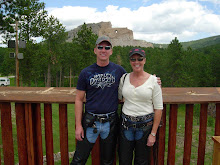This is the backside of a finished river section. Note that the piece is 12" long - the ends are the original factory cut edges. I use a bandsaw to cut the wavy edges, but you could just as easily use a utility knife.
A good sturdy utility knife with a sharp blade makes it easy to scribe the line or pattern that you want to cut. If you're cutting a straight line (for a road, for example), use a steel rule. Watch your fingers - the utility knife blade will slice through very easily if you're not careful. It's not tricky; just don't be a moron when it comes to making the scribe lines. Its better to make several shallow cuts than it is to try to make a single deep cut. You're not trying to cut all the way through the tile; just scribe it. After you've scribed the line you wish to cut along, just hold onto the tile - one hand on each side of the scribe line, and start to bend the tile along the scribe line. The tile will snap along the line. The snapped edge will leave a bit of a rough edge. You can either leave as is or just clean it up a bit with a quick pass of a piece of sandpaper.
Now that you have the basic river shape, you need to finish it. I choose to add banks to each edge of the river to give it the illusion of depth. After trying a few different methods, I settled on using caulking to form the bank shape, with sand and grit sprinkled onto the caulking to give it texture.
My narrow rivers are 1 1/2" wide, with 1/4" wide banks. This leaves 1" for the "water" section of the rivers. I mark the 1/4" out with a felt tip pen on each end, and then "eyeball" the width along the rest of the piece as I lay out a light bead of caulk along the length. Don't use too much - you can always add more. After you've squeezed out caulk along the river bank, go back with your index finger and smooth it out so it makes a nice edge on the river water side and also doesn't blob over the outside edge. While the caulk is still wet, immediately sprinkle sand/grit onto it and then put it aside and let dry.
I use Dap Kwik Seal caulk. It comes in an easy to use squeeze tube, so you don't need to use a caulking gun as you would for a standard tube of caulking. That also means you avoid the hassle of trying to control flow, and its easy to just cap it off when you're done and then take the cap off the next time and use it again without any need to remove blockages in the tube. It's acrylic, so it takes paint well. Caulk is also flexible to an extent, so it can handle drooping or bending of the vinyl tile without cracking or coming off. Great stuff.
A view of the end of the river piece. The banks are just finished with the colors and method that I use to finish my figure's bases.
Some finished river sections. The water is a blue black gloss wall and trim paint that I bought at Home Depot. Search through the paint chips until you find the color that suits your image of what a river should look like. I've tried brownish or greenish shades and didn't like them. For some reason, my brain expects water to be blue. Go figure!
As an aside, shouldn't they rename "Home Depot" as "Wargamer's Depot"? I buy quite a bit of terrain and project supplies from there...but that's another post!
To finish off the water, I apply about 3 coats of Minwax acrylic polyurethane to the river water areas. The poly is odorless and each to use and clean. I use an el cheapo brush - maybe 99 cents. Both the poly and brush are purchased at....drumroll please.......Home Depot!
And that's all that there is to it. I want to make wider sections for some major rivers to be used in WWII assault river crossings, some beach and ocean sections for amphibious actions....the sky is really the limit with what can be made.
We have a game (actually 2 games simultaneously) this Saturday night. They'll be test games of Field of Battle: Ancients. I'll post again after those games with some pictures and a report on how the rules worked.







Love this article Brent! I'm working on my rivers now! Sky's the limit with this type of tile!
ReplyDeleteAbsolutely brilliant! Thanks for sharing. Cheers!
ReplyDeleteFantastic. There's terrain hope for me yet.
ReplyDeleteI'm really looking forward to your FoB:A report.
Nice and cheap - fits my budget right. May give these a shot. Seem pretty simple and effective, and good-looking to boot.
ReplyDeleteAlso, you could use essentially the same technique for roads, just changing the colors of the edging and the road bed. For a paved road, you could just pint in some lines between the cobbles if you got a stone-looking tile color.
ReplyDeleteThese articles are fantastic; the information you show us is interesting for everybody and is really good written. It’s just great!! Do you want to know something more? Read it...: Great investment opportunity in Costa Rica
ReplyDeleteNice, simple and to the point.
ReplyDeleteI'm thinking of doing similar for the terrain tiles I use (Made from cork tiles) - Caulking/Sealant edges blended in to make it that little bit easier - not as raised off the board as seperate rivers, but I do sacrifice a little flexibility in the layout...
Ady